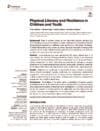Background
There is growing interest in the relationship between physical and psychosocial factors related to resilience to better understand the antecedents of health and successful adaptation to challenges in and out of school, and across the lifespan. To further this understanding, a trans-disciplinary approach was used to investigate the association between the multidimensional constructs of physical literacy (PL) and resilience in children at a key stage in their development.
Methods
Cross-sectional data were collected from 227 school children aged 9-12 years old from five schools in Winnipeg, Manitoba, Canada. Resilience was measured using the Child and Youth Resilience Measure, and physical literacy through the Physical Literacy Assessment for Youth tools. Data were provided by self-report, surrogate assessors of the child (physical education teachers and parents), and trained assessors for movement skills. These data were analyzed using correlation and logistic regression.
Results
Resilience was significantly correlated with numerous indicators of physical literacy, including movement capacity, confidence, and competence, environmental engagement, and overall perceptions of physical literacy. Regressions indicated that resilience could be predicted by movement confidence and competence, environmental engagement, and overall PL.
Conclusions
The findings of this study, using a constellation of sources, provide foundational evidence for the link between resilience and physical literacy among children, encouraging the importance of physical literacy development in schools. Longitudinal studies are required to further examine this relationship and how these previously unrelated fields may work together for a richer understanding of the interplay between the physical and psychological determinants of well-being.



Responses